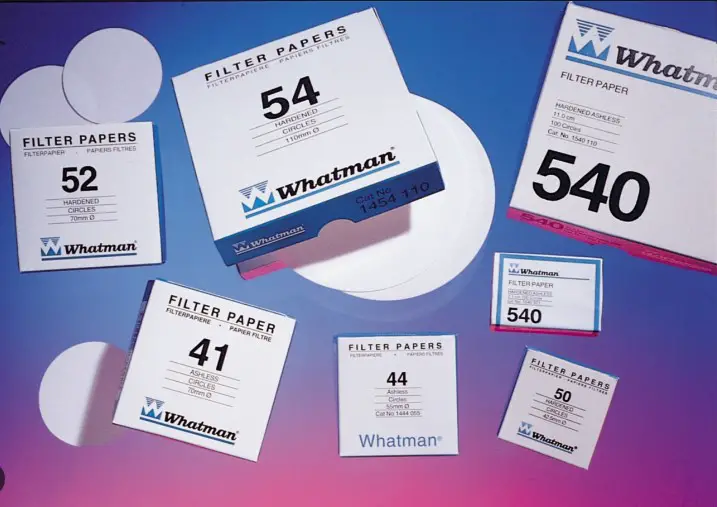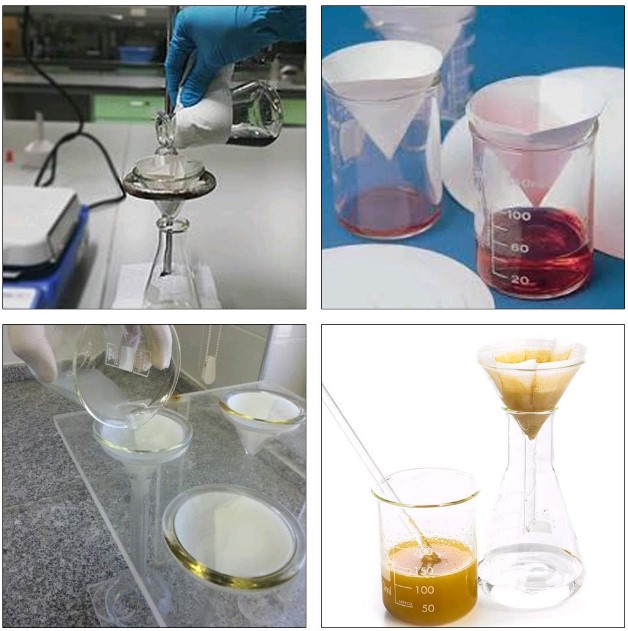In the realm of scientific research, especially within laboratories, the process of filtration stands as a cornerstone technique. It’s a method that spans across disciplines, from biochemistry to environmental science, necessitating precision and reliability. The choice of filter paper, a seemingly simple component, can significantly impact the accuracy and efficiency of this process.
The difference between Whatman Filter Paper 1 and 2 lies primarily in their composition, porosity, and application suitability. Filter Paper 1 is renowned for its versatility and is commonly used for routine applications requiring medium retention and flow rate. In contrast, Filter Paper 2 is designed for more specific tasks, offering a slightly finer particle retention and is often chosen for more precise filtrations.
Selecting the right filter paper is more than a matter of preference; it’s a decision that hinges on the specific requirements of the experimental setup and the desired outcome of the filtration process. Both types of Whatman Filter Paper bring distinct characteristics to the table, making them suited for various applications within laboratories. Understanding their differences is essential for any researcher aiming to optimize their experimental conditions.

Whatman Filter Paper Overview
History and Significance
The use of Whatman filter paper in scientific research dates back over two centuries, marking a significant advancement in laboratory techniques. This innovation was introduced by James Whatman, a name that has since become synonymous with quality and reliability in filtration. The development of Whatman filter paper represented a pivotal moment in scientific history, enabling researchers to conduct more precise and efficient experiments.
Whatman filter paper is celebrated for its consistent quality and broad range of applications, from basic laboratory filtration to complex scientific analyses. The significance of Whatman filter paper in scientific progress cannot be overstated; it has facilitated groundbreaking research in fields such as environmental science, biochemistry, and pharmacology.
Types and Uses
Whatman filter paper comes in various grades, each designed to meet specific filtration needs. The diversity in porosity, thickness, and wet strength among the different types allows for tailored application in various research scenarios. For instance:
- Grade 1: Ideal for general laboratory filtration with medium retention and flow rate.
- Grade 2: Offers finer particle retention compared to Grade 1, suitable for detailed analytical work.
- Grade 4: Provides fast filtration, perfect for coarse particles and gelatinous precipitates.
The wide array of types ensures that there is a Whatman filter paper for nearly any type of filtration need, from routine water analysis to critical research applications.
Filter Paper 1
Features
Composition
Whatman Filter Paper 1 is made from high-quality cotton cellulose, ensuring uniformity and consistency in its filtration capabilities. The natural fibers provide a balance of strength and purity, making it an excellent medium for various laboratory applications.
Porosity
The porosity of Filter Paper 1 is engineered to offer medium particle retention, typically around 11 µm. This makes it versatile for both qualitative and quantitative analysis, striking a balance between speed and clarity of the filtrate.
Weight
With a basis weight of approximately 87 g/m², Whatman Filter Paper 1 is durable yet flexible. This weight contributes to its ease of handling and resistance to tearing during use, making it a reliable choice for routine filtration tasks.
Applications
Common Uses in Labs
Whatman Filter Paper 1 is widely used across various laboratory settings for its versatility. Some of the common applications include:
- Clarifying Liquids: Removing particulates from solutions without significant loss of material.
- Air Pollution Monitoring: Collecting atmospheric particles and gases for analysis.
- Soil Analysis: Filtering particulate matter from soil extracts to analyze nutrient content and contamination levels.
Specific Scenarios for Usage
The specific properties of Whatman Filter Paper 1 make it particularly well-suited for certain scenarios:
- Precipitate Recovery: Ideal for collecting and washing precipitates due to its medium retention and good flow rate.
- Routine Laboratory Work: The go-to choice for everyday filtration needs, from preparing samples to clearing up solutions.

Filter Paper 2
Features
Composition Differences
Whatman Filter Paper 2 stands out for its distinct composition. While it retains the high-quality cotton cellulose base, the manufacturing process is tweaked to enhance its fine particle retention capability. This adjustment makes Filter Paper 2 more suited for applications requiring higher precision.
Porosity Variations
The porosity of Filter Paper 2 is finely tuned to offer a tighter particle retention than Filter Paper 1, typically around 8 µm. This characteristic is particularly beneficial for detailed analytical work where clarity and precision are paramount.
Weight Differences
With a basis weight slightly higher than Filter Paper 1, Filter Paper 2 provides additional strength and durability. This increase in weight supports its ability to handle more delicate operations without compromising its structural integrity.
Applications
Ideal Scenarios for Use
Filter Paper 2 excels in situations that demand high precision and fine particle retention. Its applications include:
- Microbiological analysis: Filtering bacterial cultures or particles for further examination.
- Food and beverage testing: Ensuring clarity and purity in quality control processes.
- Pharmaceuticals: Filtering fine particulates in product testing and research.
Comparison with Filter Paper 1
While both Filter Papers 1 and 2 are fundamental to laboratory work, Filter Paper 2 is the go-to option for tasks requiring finer filtration. Its enhanced composition and tighter porosity make it ideal for more specialized applications where detail and precision are crucial.
Key Differences
Material Composition
The primary difference in material composition between Filter Papers 1 and 2 is the treatment of the cellulose. This modification in Filter Paper 2 allows for tighter particle retention, making it more suitable for specialized tasks.
Porosity and Flow Rate
Porosity and flow rate are crucial factors that differentiate these two filter papers. Filter Paper 2’s tighter weave results in a slower flow rate but offers superior clarity, making it ideal for applications where detail is key.
Strength and Durability
Thanks to its higher basis weight, Filter Paper 2 offers greater strength and durability than Filter Paper 1. This makes it capable of handling more rigorous or sensitive filtration tasks without the risk of tearing or deteriorating.
Suitability for Various Applications
The suitability for various applications between the two filter papers is defined by their intrinsic properties. Filter Paper 1 is your versatile partner for general lab work, while Filter Paper 2 is the specialist, called upon for tasks where fine detail and precision are non-negotiable.
Selecting the Right Filter Paper
Choosing the correct filter paper is a decision that can significantly impact the outcome of your laboratory work. Here are some factors to consider and tips for optimal usage:
Factors to Consider
- Particle Size: Consider the size of the particles you wish to filter. Filter Paper 2 is better suited for retaining finer particles.
- Flow Rate: Determine your acceptable flow rate. If time is of the essence, Filter Paper 1 might be your best choice; for precision, opt for Filter Paper 2.
- Volume and Viscosity of Liquid: Higher volumes and viscosities might be better handled by Filter Paper 1 due to its faster flow rate.
- Application Specificity: Assess the specificity of your application. For general filtration, Filter Paper 1 is sufficient; for more precise separations, Filter Paper 2 is advisable.
Tips for Optimal Usage
- Pre-wetting: Pre-wet the filter paper with a compatible solvent to improve filtration efficiency.
- Compatibility Check: Ensure the filter paper is compatible with the substances being filtered to avoid any chemical reactions that might affect the results.
- Proper Handling: Handle filter papers with care to avoid contamination or damage. Use forceps or gloves to maintain integrity.
- Sequential Filtration: For extremely fine particulates, consider using Filter Paper 1 followed by Filter Paper 2 for a two-stage filtration process that balances flow rate and clarity.
Frequently Asked Questions
Can I substitute one for the other?
Substituting Whatman Filter Paper 1 for Filter Paper 2, or vice versa, is not recommended without considering the specific needs of your application. While both serve the general purpose of filtration, their differences in porosity and particle retention can significantly affect the outcomes of your experiments. It’s crucial to match the filter paper to the task at hand for optimal results.
How does the choice affect filtration results?
The choice between Whatman Filter Paper 1 and 2 can influence the clarity, speed, and efficiency of your filtration process. Filter Paper 1, with its medium retention and flow rate, is suitable for general-purpose filtration and provides a balance between speed and clarity. Filter Paper 2, with finer particle retention, is better suited for applications requiring greater clarity and precision, though at a potentially slower flow rate. Selecting the appropriate filter paper ensures that the filtration process meets the specific needs of your research.
Conclusion
The nuanced differences between Whatman Filter Paper 1 and 2 underscore the importance of informed selection in scientific research. Choosing the right filter paper is not merely a procedural step; it is a critical decision that can dictate the reliability and accuracy of experimental results.
Understanding these differences enables researchers to tailor their filtration process to their specific needs, ensuring that the integrity of their work is upheld. As we continue to push the boundaries of scientific inquiry, the meticulous selection of seemingly minor tools, such as filter paper, remains a testament to the rigorous standards of the scientific community.
